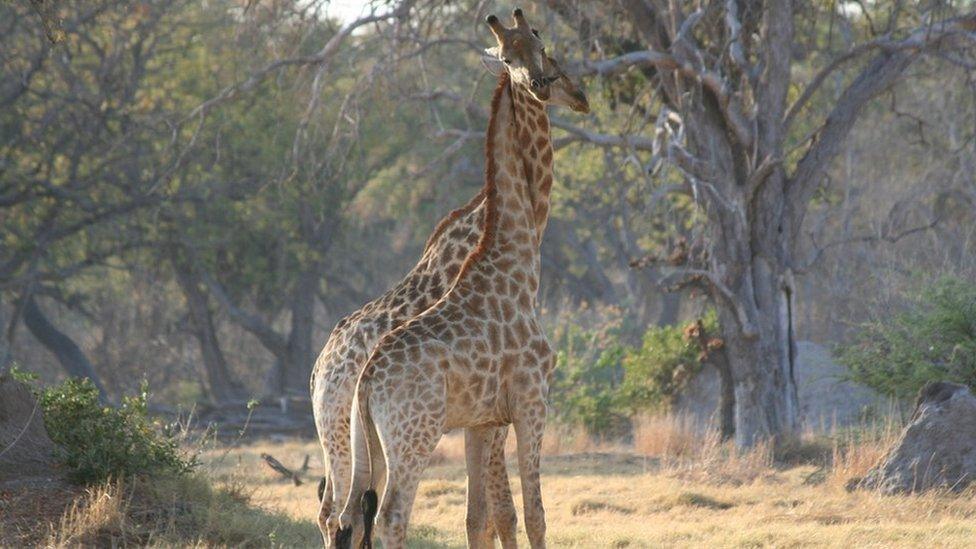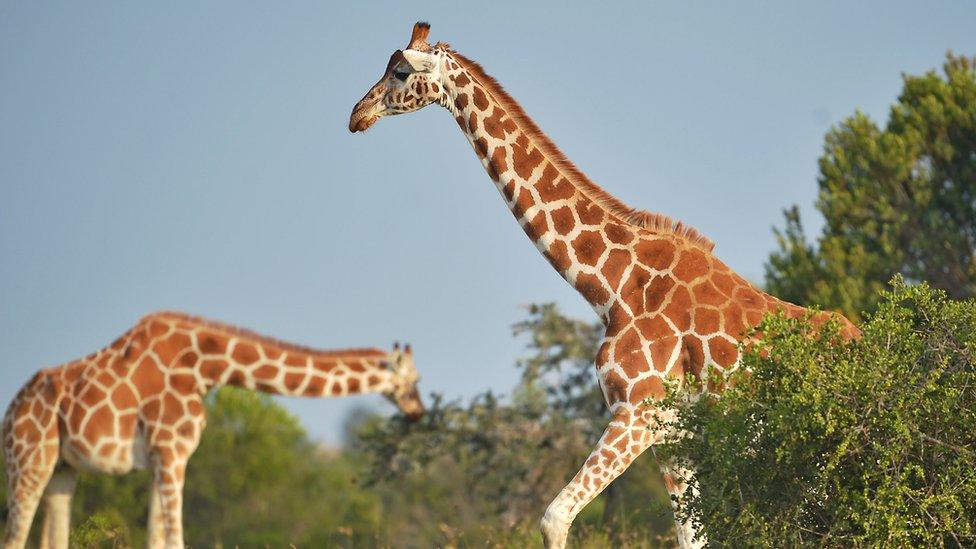Giraffes facing 'silent extinction' as population plunges
- Published
- comments

A combination of factors has helped drive down giraffe populations in many parts of Africa
A dramatic drop in giraffe populations over the past 30 years has seen the world's tallest land mammal classified as vulnerable to extinction.
Numbers have gone from around 155,000 in 1985 to 97,000 in 2015 according to the International Union for the Conservation of Nature (IUCN).
The iconic animal has declined because of habitat loss, poaching and civil unrest in many parts of Africa.
Some populations are growing, mainly in southern parts of the continent.
Until now, the conservation status of giraffes was considered of "least concern" by the IUCN.
However in their latest global Red List, external of threatened species, the ungainly animal is now said to be "vulnerable", meaning that over three generations, the population has declined by more that 30%.
According to Dr Julian Fennessy, who co-chairs the IUCN giraffe specialist group, the creatures are undergoing a "silent extinction".
"If you go on a safari, giraffes are everywhere," he told BBC News.
"While there have been great concern about elephants and rhinos, giraffes have gone under the radar but, unfortunately, their numbers have been plummeting, and this is something that we were a little shocked about, that they have declined by so much in so little time."
The rapid growth of human populations has seen the expansion of farming and other forms of development that has resulted in the fragmentation of the giraffe's range in many parts of Africa. But civil unrest in parts of the continent has also taken its toll.
"In these war torn areas, in northern Kenya, Somalia, and Ethiopia in the border area with South Sudan, essentially the giraffes are war fodder, a large animal, extremely curious that can feed a lot of people," said Dr Fennessy.
Habitat loss and war are among the ways humans have caused the big drop in giraffe numbers, says Mike Jordan of Chester Zoo
A study in recent months suggested that the giraffe was actually four different species but for this update of the Redlist, the IUCN have stuck with the traditional definition of one species with nine subspecies.
Of these, five have had falling populations, one has remained stable while three have grown. Different outcomes seem to be highly dependent on location.

The curious nature of the giraffe makes them an easier target for hunters and armed gangs
"The species in southern Africa, those numbers are increasing by two to three times over the last three decades," said Dr Fennessy.
"But when you come up through East Africa, those numbers have plummeted some by up to 95% of the population in the case of the Nubian giraffe, in the last three decades alone."
Solutions exist
While researchers believe that some local populations may not survive, there is optimism that that the long term future of these tall creatures can be secured.
The success in keeping giraffe numbers high in Southern Africa has much to do with the management of game parks for tourists say experts, who believe that the extra attention that the IUCN listing will now attract will benefit the species.
"South Africa is a good example of how you can manage wildlife, there is a lot of moving of animals between different conservation areas, it is a very different scenario than in most of the rest of Africa." said Chris Ransom from the Zoological Society of London.
"I think giraffes can survive, with the right conservation efforts, and we can ensure that the animals do live in the wild. There are a lot of cases of success in conservation. The giraffes could be one."
The latest edition of the IUCN Red List now contains over 85,000 species in total with more than 24,000 threatened with extinction. Over 700 newly recognised bird species have been added, with 11% of them on the edge of survival.
One bird, the Antioquia wren has been listed as "endangered" as more than half of its habitat in Colombia could be wiped out by proposed dam.
Invasive species on islands are also seen as a threat for many birds including the Pagan reed-warbler and the Laysan honeycreeper.

The Java sparrow is now regarded as vulnerable in the Red List classification
The publication also includes the first assessment of crops including wild oats, barley, mango and other wild relative plants.
"Many species are slipping away before we can even describe them," says IUCN Director General Inger Andersen. "This IUCN Red List update shows that the scale of the global extinction crisis may be even greater than we thought."
Follow Matt on Twitter, external and on Facebook, external